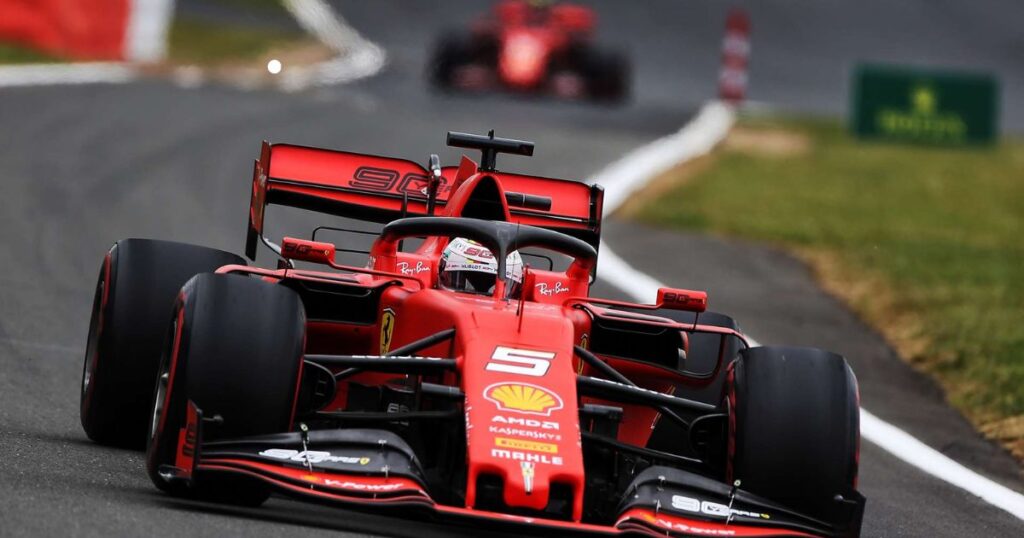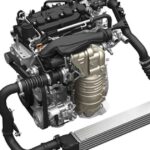Formula 1 cars are renowned for their lightning-fast speeds, with top race velocities exceeding 372.5km/h (231.4mph). This unparalleled speed is achieved through a perfect storm of cutting-edge technology and engineering brilliance.
These sleek machines boast powerful engines, advanced aerodynamics, and lightweight construction, enabling them to accelerate from 0-60mph in just 2.6 seconds. F1 cars are meticulously designed to harness every ounce of power, making them the epitome of speed and precision in the world of motorsport.
How fast is an F1 car? Top speeds of F1, IndyCar, MotoGP and more
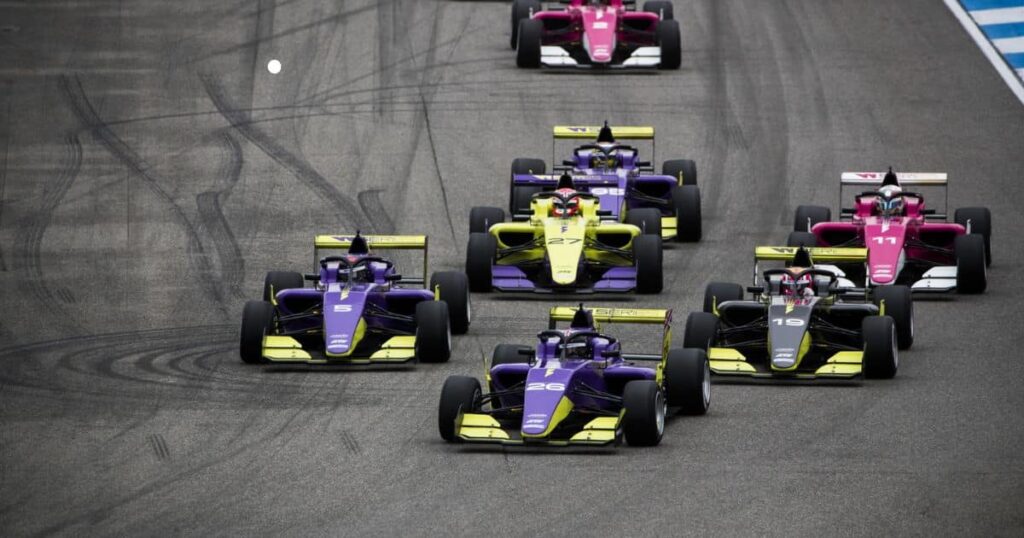
To truly appreciate the speed of F1 cars, it’s helpful to compare them to other elite racing series governed by the Fédération Internationale de l’Automobile (FIA).
Here’s a rundown of the jaw-dropping top speeds:
Formula 1
- Top Race Speed: 372.5 km/h / 231.4 mph
- Fastest Ever Recorded Speed: 397.36 km/h (246.9 mph)
- 0-60 mph Acceleration: Approximately 2.6 seconds
Despite their blistering pace, F1 cars surprisingly aren’t the fastest single-seaters on straights. That accolade goes to IndyCar. However, thanks to their immense downforce and superior cornering abilities, F1 cars are generally quicker over an entire lap.
IndyCar
- Top Speed: 380 km/h / 236 mph
- 0-100 km/h Acceleration: Approximately 3 seconds
IndyCars hit some of the highest top speeds in motorsport, occasionally exceeding 380 km/h on long straights. While quicker than F1 in a straight line, they take slightly longer to reach those mind-numbing velocities.
MotoGP
- Top Speed: 366.1 km/h / 227.4 mph
- 0-100 km/h Acceleration: Approximately 2.6 seconds
Brad Binder set the record for MotoGP’s fastest speed of 366.1 km/h at Mugello in 2023. While slower than F1 over a full lap, these superbikes are impressive sprinters off the line with 0-100 km/h times matching F1 cars.
NASCAR
- Top Speed: Just over 321 km/h / 199 mph
- 0-96 km/h Acceleration: 3.4 seconds
For safety reasons, NASCAR has actively restricted top speeds since the 1980s after some harrowing incidents. The heavy stock cars also hamper outright pace despite their grunt.
Formula 2
- Top Speed: 335 km/h / 208 mph
- 0-100 km/h Acceleration: 2.9 seconds
Formula 2 (F2) serves as a feeder series to F1. While blisteringly fast, F2 cars tend to lap 10-15 seconds slower than their F1 counterparts.
Formula 3
- Top Speed: 300 km/h / 186 mph
- 0-100 km/h Acceleration: 3.1 seconds
Formula 3 (F3) sits a rung below F2, with slightly lower top speeds around 300 km/h but still remarkably quick acceleration for a junior formula.
Formula E
- Top Speed: 322 km/h / 200 mph
- 0-100 km/h Acceleration: 2.8 seconds
The electric Gen3 cars in Formula E hit a respectable 322 km/h, albeit slower than F1 due to environmental priorities over outright speed. But their 0-100 km/h times match elite gas-powered series.
DTM
- Top Speed: 302 km/h / 187 mph (approx.)
- 0-100 km/h Acceleration: 3 seconds (approx.)
Germany’s touring car series DTM (Deutsche Tourenwagen Masters) features high-speed silhouette racers cracking 300 km/h.
WTCR
- Top Speed: 260 km/h / 161 mph (approx.)
- 0-100 km/h Acceleration: 4.5 seconds
The World Touring Car Cup racers are based on production models and regulated to make for close competition, limiting their top speeds.
WRC
- Top Speed: 200 km/h / 124 mph (approx.)
- Acceleration: Surface dependent
In the rough and tumble World Rally Championship (WRC), outright top speed takes a back seat to acceleration, braking, and handling on varied terrain. Even 200 km/h is considered too fast for some stages!
V8 Supercars
- Top Speed: 300 km/h / 186 mph (approx.)
Australia’s V8 Supercars touring car series sees its muscle cars hit 300 km/h before braking for the next corner.
WEC
- Top Speed: 343 km/h / 213 mph (approx. Hypercar class)
The FIA World Endurance Championship features cutting-edge prototypes and hypercars that can surpass 340 km/h on key straights like the Mulsanne at Le Mans.
Super Trofeo
- Top Speed: 325 km/h / 201 mph
- 0-100 km/h Acceleration: 3.2 seconds
The Lamborghini Huracans used in this single-make series showcase the performance of advanced road-derived supercars.
Isle of Man TT
- Top Speed: 322 km/h / 200 mph (approx.)
The iconic Isle of Man TT sees production-based superbikes reach astounding speeds on tight, twisting public roads in one of the most dangerous races.
Top Fuel Dragsters
- Top Speed: 544 km/h / 338 mph (approx.)
- 0-530 km/h Acceleration: 3.7 seconds
And leaving them all in the dust are the incredible Top Fuel dragsters, hitting over 540 km/h in mere seconds from a standing start in the ultimate acceleration contest!
As this overview demonstrates, while F1 cars aren’t always the fastest in a straight line, their combination of power, downforce, and agility make them the performance kings over a full lap or circuit.
More Post:
Who Makes Infiniti Cars
How fast are F1 cars 0-60 mph?
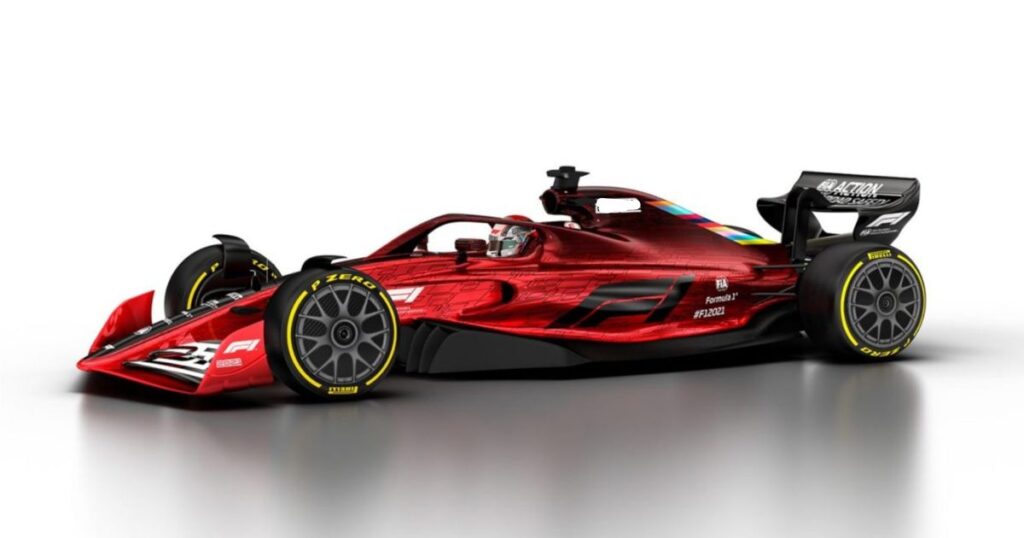
One of the most staggering aspects of F1 car performance is their brutal acceleration. Most road-going supercars would be left eating dust as a modern F1 racer rips from 0-60 mph (0-97 km/h) in just 2.6 gut-wrenching seconds.
To put that in perspective, here’s how it stacks up against some performance icons:
- Bugatti Chiron: 0-60 in 2.3 seconds
- Ferrari SF90 Stradale: 0-60 in 2.5 seconds
- Porsche 918 Spyder: 0-60 in 2.6 seconds
- Dodge Challenger SRT Demon: 0-60 in 2.3 seconds
So an F1 car can essentially match or out-accelerate even the most elite supercars and hypercars off the line. And they don’t stop pulling there F1 cars also blitz from 0-100 mph (0-161 km/h) in a mere 4.2 scary seconds.
While their incredible aerodynamics actually hamper acceleration from a standstill, once rolling, that downforce helps them build speed at a terrifying rate. The fierce G-forces would liquify most drivers.
What is the top speed of a 2023 F1 car?
In 2023, the highest speed officially recorded during an F1 race weekend was a sizzling 353.8 km/h (219.8 mph) by Daniel Ricciardo in qualifying for the Mexico City Grand Prix.
The main straight at Mexico City’s Autódromo Hermanos Rodríguez is over 1.2 km long, and being 2,285 meters above sea level, the thin air reduces drag for even higher top speeds.
The outright record for the fastest speed achieved by an F1 car was set outside of a race weekend. In 2005, Honda took their F1 car, the RA106, to the Bonneville Salt Flats in Utah for a straightline speed test. On this incredibly flat and level surface, the RA106 managed to hit an astonishing 397.36 km/h (246.9 mph)!
During actual Grand Prix races though, the highest top speed is still an incredible 372.5 km/h (231.4 mph), set by Valtteri Bottas during the 2016 Mexican GP.
To reiterate, while these are the highest peaks, F1 cars don’t maintain those velocities consistently. Over an entire lap, average speeds are generally in the 230-260 km/h range depending on the circuit layout and configuration. But experiencing even just a few seconds at over 300 km/h must be utterly breathtaking for the drivers.
How do F1 cars’ downforce work?
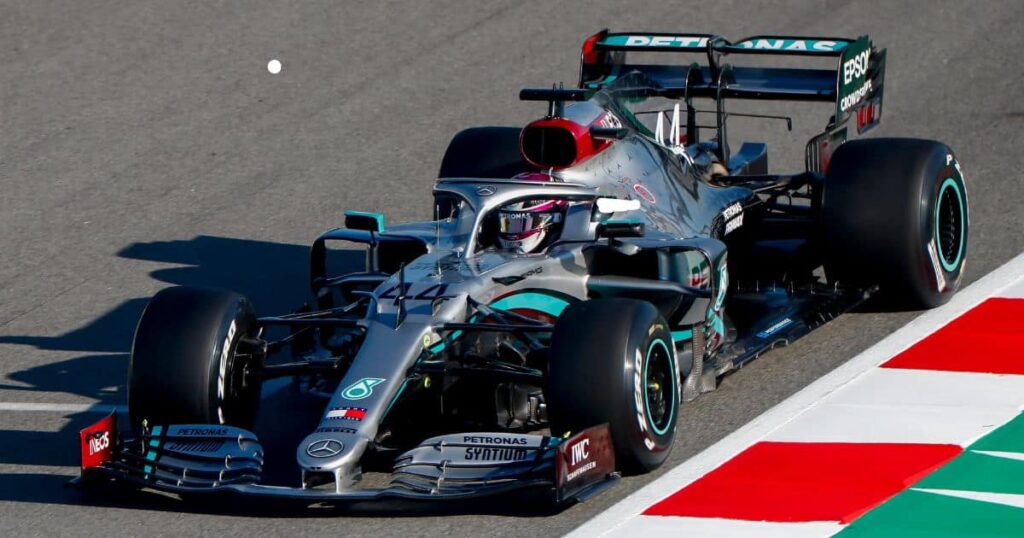
A huge reason why F1 cars can achieve such incredible lap times and cornering speeds is the immense downforce their designs generate. Downforce is a downwards-pushing aerodynamic force that increases grip and allows for higher corner speeds before reaching adhesion limits.
F1 cars create downforce through meticulously sculpted wings, underbody aerodynamics, and finely tuned airflow management. The front and rear wings are precisely shaped and angled to force airflow in directions that generate downward pressure, effectively “pushing” the car into the track surface.
Advanced computational fluid dynamics (CFD) simulations and wind tunnel testing allow engineers to virtually model and optimize these aero surfaces to maximal effect. The underside of the car is designed as a venturi-shaped underbody to accelerate airflow and create a low-pressure zone that quite literally sucks the car onto the track.
At the rain-soaked 2023 Monaco GP, Max Verstappen’s Red Bull generated a whopping 3,246 lbs (1,472 kg) of downforce, despite the wet conditions reducing that figure. At faster circuits, over 5,000 lbs of downforce is possible!
This immense grip allows drivers to corner at mind-bending speeds while experiencing incredible G-forces that would render a regular human unconscious. It’s a key factor in what makes modern F1 cars so blisteringly quick around a lap.
Are F1 cars street legal?
In short, no, F1 cars are emphatically not street legal machines that could be registered for road use.
There are numerous reasons for this:
- Extreme Design: F1 cars are sculptured solely for maximum speed and performance on a racetrack. Design elements like protruding wings, open wheels, and the lack of things like lights make them illegal.
- Safety Regulations: F1 chassis provide world-class safety for drivers in a crash, but they lack basic safety features mandated for road cars like crumple zones, airbags, etc.
- Lack of Amenities: There is no air conditioning, radio, or any type of comfort feature on an F1 car. It is a stripped down, single-purpose machine.
- Ride Height: The extremely low ride height of just a few inches off the ground would make driving on normal roads completely impractical.
While not street legal, some of the world’s most extreme hypercars and track-focused supercars do share some functional similarities with F1 racers:
- Radical Track Cars: Cars like the Ariel Atom or BAC Mono are road-legal in some areas despite their race-bred performance focus.
- Production Hypercars: Models like the Aston Martin Valkyrie, Mercedes-AMG One, and Lamborghini Sian feature race-derived hybrid powertrains, aerodynamics and materials like F1 cars.
So in essence, while not road-legal whatsoever, the spirit and performance ethos of F1 design does trickle down to the ür-exotics you may spot on city streets.
How much G-force do F1 drivers experience?
Along with piloting a car at over 300 km/h mere inches from oblivion, F1 drivers also have to endure enormous G-forces during braking, acceleration and high-speed cornering. G-forces refer to the physiological stresses of acceleration, measured in multiples of the normal force of gravity (1G).
During braking from top speeds, F1 drivers can experience up to 5.5 G’s slamming their bodies forward violently. They must develop incredible neck strength to withstand the sheer force trying to whip their head forwards.
Certain high-speed corners like the famed 130R at Suzuka can generate a petrifying 6 G’s of lateral acceleration force, feeling like you weigh six times normal! Drivers’ bodies are pinned against their seats while their senses reel from the crushing centrifugal forces.
Speaking of centrifugal force, F1 drivers get battered again under acceleration out of slow corners. When planting the throttle coming off an apex, they can experience 4-5 G’s in the opposite direction, feeling like their body is being pulled outwards. It’s an intense physical challenge.
Overall, these sustained high G-loadings require incredible physical conditioning and endurance training from drivers. Strengthening muscles, building upper body strength, and developing high heat/humidity tolerance are crucial to withstand these forces for 2 hours in the cockpit.
Without the athleticism of an elite fighter, drivers would quickly fatigue and lose consciousness under the immense strains of piloting an F1 missile around a circuit.
What Is The Top Average Speed of F1 Cars Today?
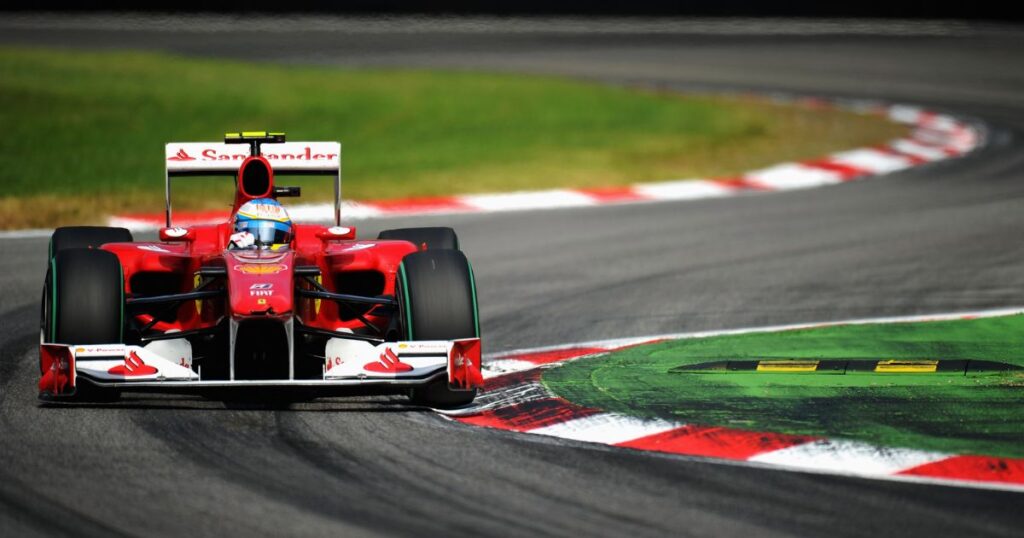
While outright top speeds provide the viral highlights, a car’s overall average lap speed tells a more complete story of its performance. For context, the fastest hot hatchbacks top out around 250-270 km/h, but struggle to average over 130 km/h even on a racetrack.
In Formula 1, qualifying lap records illustrate the average speeds modern F1 cars can sustain over a full lap. At the 2023 Spanish Grand Prix, Max Verstappen’s pole lap averaged a scarcely believable 234.2 km/h (145.5 mph) around the 4.6 km Circuit de Barcelona-Catalunya.
To visualize what an average speed like that entails, consider:
- Most highway speed limits top out at 120-130 km/h
- Commercial passenger jets take off and land around 250 km/h
- The Eurofighter Typhoon jet has a top speed of around 2,495 km/h
So for a 1.6 hour Grand Prix distance, today’s F1 cars can maintain average race speeds just shy of a fighter jet’s top velocity! It’s an astounding demonstration of their performance capabilities over a full distance.
Other incredible average speed examples from pole laps in 2023 include:
- Monaco: 171.7 km/h
- Saudi Arabia: 263.1 km/h
- Australia: 261.6 km/h
- Miami: 227.9 km/h
The overall fastest qualifying lap average in F1 history currently stands at a ludicrous 264.362 km/h (164.03 mph) by Lewis Hamilton at Monza in 2020. For comparison, that’s only about 25% slower than a fighter jet!
These statistics drive home the phenomenal performance capabilities of modern F1 cars in being able to sustain extreme speeds for an entire grueling Grand Prix race distance. It’s simply mind-boggling.
Evolution of F1 Race Cars’ Speed & Technology
While today’s F1 cars represent the bleeding edge of speed and performance, their predecessors were also revolutionary in their time. The remarkable evolution and development of F1 cars over the decades is a fascinating story of human ingenuity.
Here are a few of the major technological advances that have taken place:
Aerodynamics & Computational Fluid Dynamics (CFD)
- Pioneering use of wind tunnels to model and improve aero design
- Advanced CFD software simulations optimize aero elements like wings and underbodies
- Result: Vastly increased downforce for higher cornering speeds
Lightweight Materials & Construction
- Transition from steel chassis to aluminum, carbon fiber composites
- Implementation of honeycomb and sandwich materials
- Enables much lighter yet stronger/stiffer chassis and components
Hybrid Power Units and Energy Recovery Systems
- Shift from pure internal combustion engines to hybrid systems
- Kinetic and heat energy recovery systems capture/redeploy wasted energy
- Allows for increased power output while improving efficiency
Active Suspension and Electronics
- Semi-active and active suspension systems to optimize mechanics
- Fly-by-wire throttle, advanced traction/stability controls
- Enables maximum mechanical grip and improved driver aids
Endless Prototyping and Innovation
- Constant R&D by teams to find new advantages year over year
- Wind tunnels, CFD, advanced materials, and cutting-edge manufacturing
- Helps extract maximum performance with each new design iteration
This perpetual innovation and development in fields like aerodynamics, lightweighting, powertrain efficiency, and electronic controls has been the driving force behind F1’s relentless pursuit of speed. What seemed ludicrously fast decades ago is merely the baseline for modern race engineers.
Are There Any Regulations Limiting Top Speeds In F1 Cars?
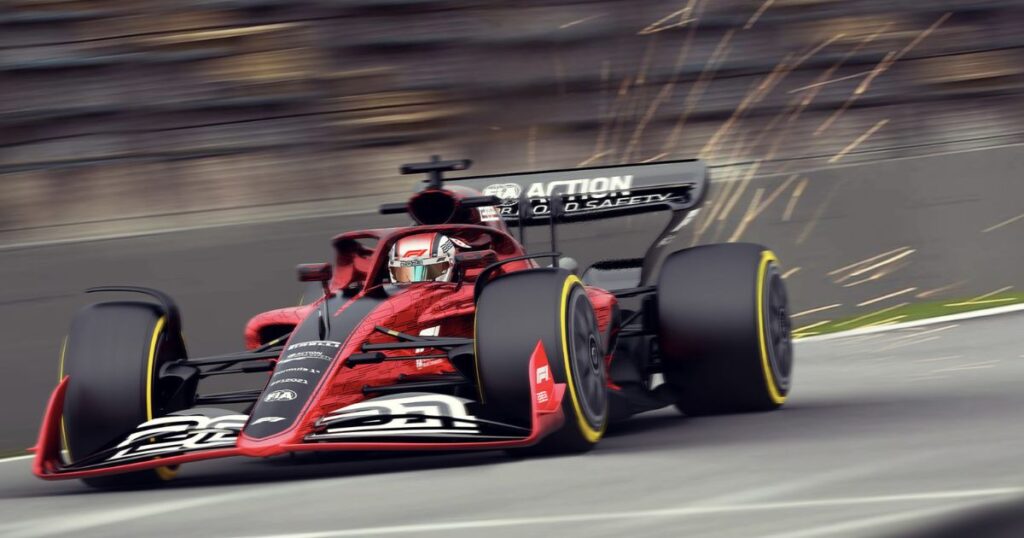
While the competitive nature of F1 fuels teams to push for every last km/h, the Fédération Internationale de l’Automobile (FIA) does implement certain regulations to limit outright top speed in the interests of safety and closer competition.
Some key speed-limiting rules and specifications include:
Engine Displacement and Power Limits
- Current F1 engines restricted to 1.6L turbocharged V6 configuration
- Power output capped at around 1,000 hp combined from engine and hybrid system
Aerodynamic Restrictions
- Stringent limits on size and geometry of front/rear wings
- Sliding scale handicaps applied to limitDownForce levels
Drag Reduction System (DRS) Zones
- Movable rear wing flap can open on straights to reduce drag
- But only permitted in specified DRS activation zones
Gear Ratios and Fuel Flow Limits
- Teams must homologate their gear ratios, limiting maximum revs achieved
- Strictly enforced fuel flow rate restricts potential engine power
So while teams are always striving for more speed, the FIA aims to strike a balance between outright performance and ensuring cars remain drivable and safe at the upper limits.
It’s a delicate line to tread – allow too much speed and the risks become extreme. Too many limits and fans lose some of the thrill and spectacle that attracts them to F1 in the first place.
More Post:
How Many Cubic Yards Of Concrete Can A Truck Carry?
What Kind Of Safety Measures Are Needed For F1 Cars
With the incredible speeds and G-Forces involved, comprehensive safety systems are absolutely crucial in Formula 1 racing. Let’s look at some of the key safety measures and design elements:
Carbon Fiber Survival Cell
- The monocoque cockpit “tub” is a rigid safety cell made from carbon fiber
- Designed to protect the driver’s body with front/rear impact structures
- Must meet stringent crash test standards set by the FIA
Cockpit Design and Extraction
- Cockpit aperture shaped for easy driver extraction after crashes
- Removable steering wheel and water-aided driver extraction systems
Shielding and Safety Equipment
- Helmets, HANS devices, fire-retardant suits, layers of Nomex protection
- Bulletproof “Zylon” panels to withstand debris impacts
- The halo titanium cockpit protection frame added in 2018
Circuit Safety Features
- Reinforced barriers, tire bundles, gravel/tarmac run-off areas
- Designed to maximize deceleration zones and dissipate crash energy
- Advanced marshalling/medical intervention and recovery teams
The incredible success of these overlapping safety protocols is highlighted by the fact that there has not been a single fatal accident involving a contemporary F1 car design since Ayrton Senna and Roland Ratzenberger tragically lost their lives in 1994.
While the dangers of motorsports can never be fully eliminated, every effort is made in F1 to push safety to the highest possible standards as speeds continue increasing. Drivers rely on this engineering and preparation to keep them protected at over 300 km/h.
What Is The Future of F1 Speed & Technology?
As miraculous as today’s F1 cars are, teams and engineers are already working to take performance to even higher levels in the years ahead. Some potential areas for future development include:
Active Aerodynamics
- Morphing aerodynamic body surfaces that change shape at speed
- Could provide unprecedented levels of downforce and minimize drag
Lighter, Stronger Materials
- Continuing evolution of exotic composites, alloys, and materials science
- Ever lighter yet stronger components and chassis structures
Higher Efficiency Powertrains
- Increasing electrical power contribution and advanced battery tech
- Potentially moving to full-electric drivetrains with tremendous torque
Augmented Driver Displays and Aids
- Helmet/eye-tracking HUDs for enhanced situational awareness
- AI-assisted driving advisories optimized for each corner/condition
Advanced On-Board Computing/Telemetry
- Powerful on-board computational capabilities and modeling
- Sensors and telemetry gathering an immense amount of real-time data
The future truly seems limited only by human imagination and technical capability. Proposed concepts like active aerodynamics and autonomous/AI driver assistance could massively increase achievable speeds.
The only certainty is that speeds and performance considered wildly futuristic today will likely seem quaint in a few decades’ time. The limits are always being reset to propel F1 cars faster and faster.
What are the costs associated with F1 cars?
The astronomical costs involved in designing, developing, and operating a modern Formula 1 car each season are simply staggering:
Design and R&D Costs
- Teams spend $100s of millions annually on research and development
- Computational fluid dynamics simulations, wind tunnel testing, prototyping
- Developing new state-of-the-art technologies and innovations
Manufacturing
- Producing the monocoque chassis and components from exotic materials
- Carbon fiber work, specialty metal alloys, electronics integration
- Cost of an actual F1 chassis is estimated at over $10 million itself
Engine and Powertrain
- The sophisticated hybrid turbo powertrains cost around $15 million each
- Teams designing and manufacturing in-house engines spend even more
- Cost of development, materials, specialized manufacturing processes
Operational and Logistics
- Transportation of dozens of tons of equipment globally
- Hundreds of team personnel for race operations and support
- Top teams have operational budgets over $400 million annually
In total, the biggest teams like Mercedes, Ferrari and Red Bull spend over $500 million per year chasing F1 glory! While not financially viable as a commercial product, the technology, innovation and performance makes every dollar spent worthwhile for manufacturers.
What are the differences between F1 cars and other race cars?
While all purposely designed for blistering speed, F1 cars do differ notably from other top-tier race cars like Le Mans Prototypes, IndyCars or production-based categories.
A few key differences:
Lower Weight and Downforce Priority
- F1 cars are extremely light, focused on generating maximum downforce
- Le Mans prototypes built more for higher top speeds, less grip
- GT cars based on production models are heavier with less downforce
Specialization vs Versatility
- F1 design is ultra-specialized just for tight, twisty permanent circuits
- IndyCars aim for a balance of oval/road course performance
- WEC/IMSA prototypes need versatile set-ups for mixed racetracks
Construction and Materials
- F1 cars use exotic lightweight composites like carbon fiber extensively
- IndyCars blended composites and more conventional materials
- LMP2/GT cars mandated to use some production-based components
Power Sources
- F1’s sophisticated hybrid turbo powertrains most complex
- LMP1s used similar hybrid systems when category was active
- Most others rely on pure internal combustion engines still
So while all designed to achieve extreme performance, different philosophies and regulations lead to some variation in how that performance is generated and prioritized for each type of race car. But all are extraordinary feats of engineering.
Also Read:
Should A Car Be Running When Adding Oil?
Frequently Ask Question
What makes F1 cars go so fast?
F1 cars achieve their incredible speeds due to a combination of factors, including lightweight construction, powerful engines, advanced aerodynamics, and high-tech tires, all meticulously designed for maximum performance.
Is anything faster than F1?
Yes, in a straight line, certain vehicles like dragsters and some hypercars can surpass the top speeds of F1 cars, although F1 cars excel in terms of overall lap times and cornering speeds.
What is the highest speed ever recorded in F1?
The highest speed ever recorded in an F1 car during a race is 372.5km/h (231.4mph), achieved by Valtteri Bottas during the 2016 Mexican Grand Prix.
Is Bugatti faster than F1?
In terms of top speed, certain Bugatti models like the Chiron Super Sport 300+ have achieved speeds higher than those of F1 cars. However, F1 cars are designed for track performance and agility, excelling in areas where road cars like Bugattis might fall short.
What’s the fastest a car has ever gone?
The fastest speed ever recorded by a car is approximately 763 mph (1,227 km/h), achieved by the ThrustSSC in 1997, making it the first car to officially break the sound barrier.
What Are Some of The Biggest Events In F1 Racing?
Some of the biggest events in F1 racing include the Monaco Grand Prix, the British Grand Prix, the Italian Grand Prix at Monza, and the Abu Dhabi Grand Prix. These races attract millions of viewers worldwide and are known for their rich history and thrilling competition.
Final Thought
F1 cars achieve remarkable speeds due to a blend of cutting-edge technology and engineering prowess. Their lightweight yet robust construction, coupled with powerful engines and advanced aerodynamics, allows them to reach astonishing velocities.
These cars boast acceleration times as quick as 2.6 seconds from 0-60mph, with top race speeds exceeding 372.5km/h (231.4mph). Their agility on the track, high cornering speeds, and relentless pursuit of performance make F1 cars the pinnacle of motorsport engineering, captivating fans worldwide.

